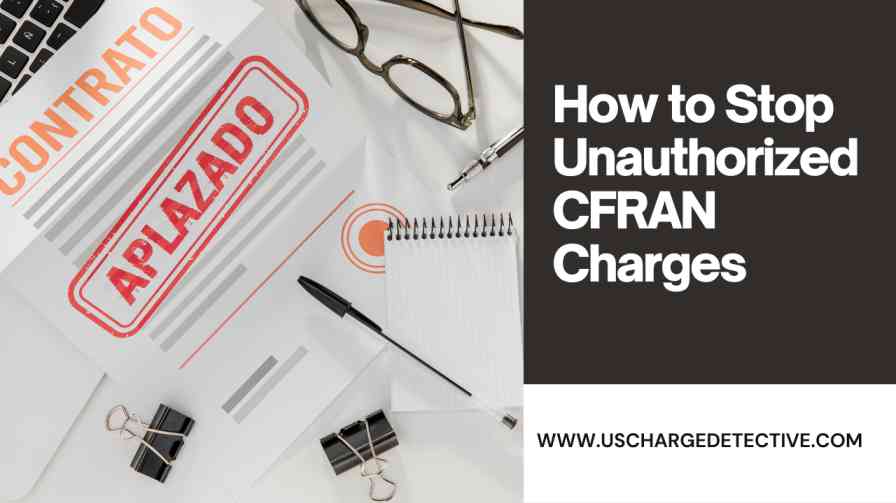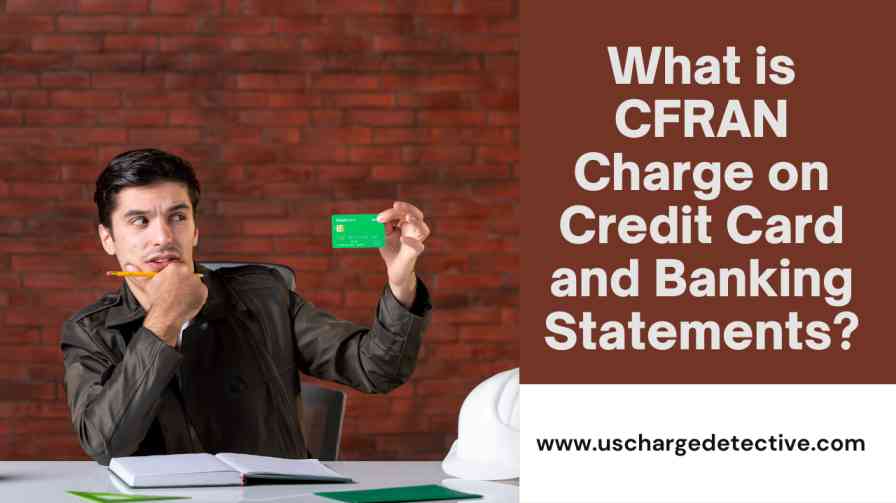Credit card transactions and banking are daily occurrences in the fast-paced digital environment of today. On occasion, though, unanticipated charges show up on your statements and you start to wonder. The CFRAN charge is one of these enigmatic levies. You are not alone if you have ever found a CFRAN charge on your credit card or bank statement. What then precisely is it, and why has it appeared on your statement?
This post will break out all you need to know about CFRAN charges on your credit card, debit card, and bank statements. We have you covered whether you recently observed this charge or want a better understanding of your financial accounts.
Must Read: What Is ss Market Sandusky Ohio Charge On Credit Card?
Your credit card statement shows a CFRAN charge of what?
Looking over your monthly credit card or bank statement could see a transaction marked CFRAN. This charge may seem foreign and cause questions. CFRAN is, all things considered, usually an acronym connected to a certain kind of retailer or service provider. Still, the acronym itself might not exactly indicate the name of a company or service you know.
Usually stemming from online transactions or automated services where the merchant’s identity isn’t shown, CFRAN costs are You might have paid for a subscription, made an in-app purchase, or subscribed to a service, only for the merchant to show as CFRAN on your statement.
Common CFRAN Charge Motives
What then explains a CFRAN charge showing up? Here are a few typical causes:
- Online Subscriptions: Third-party billing systems are used by many online services. A company you subscribed to might have a CFRAN label since it outsourced its payment processing.
- Regular payments: Should you have configured auto-pay for any services, the regular payment may show under a CFRAN code.
- One-Time Buying: Sometimes one-off purchases—especially from foreign or less-known stores—show up as a CFRAN charge.
Although these factors help to explain why this charge could show up, you should look into any costs you are not familiar with.
Is the charge for CFRAN fraudulent?
Not knowing a charge causes one to get scared naturally. Is the CFRAN charge, then, fake? Not inevitably.
The look of the CFRAN code may not always indicate fraud. It could be a real charge that just shows under another name because of how the retailer handles payments. If you believe the charge is illegal or fraudulent, nevertheless, you should act right once.
How might one find a CFRAN charge?
Finding out what a CFRAN charge is best for requires:
- Examine Your Recent Purchases: Go over your most recent purchases. Sometimes the charge comes from a service you frequent but didn’t anticipate showing up with this title.
- Go over emails or receipts: Search your email for purchase receipts or confirmation notes to assist with charge tracking.
- Make a merchant call: Ask straightforward questions if you have doubts about the company the charge relates to.
Regarding financial management, these actions can save time and help to avoid needless stress.
Actions to Follow upon Seeing a CFRAN Charge
Should the CFRAN charge eludes you, use these guidelines:
- Verify the charge: Look for any receipts, web orders, or subscriptions that can help to explain the amount.
- Speak with your credit card company or bank: The next best thing to do if you can’t find the charge is to get in touch to your bank. They can either offer further details or perhaps speak with the retailer on your behalf.
- Dispute the charge (should it be necessary): Should you feel the transaction is fraudulent, you can dispute it with your credit card company or bank to get it reversed.
How to Stop Unauthorized CFRAN Charges

Although it’s upsetting to see random or illegal charges showing on your account, there are actions you can take to stop them:
- Check your statements often: Review your statements at least once a month on average.
- Choose safe payment techniques: To decrease risk, choose safe options including virtual credit cards or PayPal.
- Set limits on subscriptions: Maintaining awareness of all the services you subscribe to helps to avoid uncertainty around charges like CFRAN.
Noting Your Bank Regarding CFRAN Charges
Should you follow all the guidelines and still find the CFRAN fee difficult to identify, you should get in touch with your bank. You should know these things:
- Give specific information: Ready to provide your credit card information, the charge amount, and the date the charge is shown on your statement?
- Request clarification: Your bank could have tools or extra resources to enable you to find the merchant behind the charge.
- Initiate a dispute (should it be necessary): If you are positive the charge is fake, ask your bank to initiate an official dispute procedure.
Know Merchant Codes and Their Function
CFRAN could be a merchant category code (MCC), used by banks to categorize companies. Under such codes, merchants handling a variety of services occasionally combine their costs. These rules could be confusing for consumers even if they help the bank to streamline matters.
How Often Do CFRAN Charges Apply?
Although CFRAN accusations are not very common, they do occasionally surface. Usually, they show up while shopping from smaller, foreign stores or internet subscription companies. Many believe the CFRAN label is fake as its anonymity adds further mystery to these claims.
Is the CFRAN charge refundable?
You can still be qualified for a refund even if you confirmed the CFRAN charge is valid but felt the service was inadequate. Most stores offer a return window; however, it is advisable to get in touch with them. Should the merchant deny a refund, your bank could help via a chargeback process.
Action to Take Should Your CFRAN Charge Be Valid
Once you find the charge is valid, you should:
- Track the merchant closely: Note the business or service so you won’t be surprised by the next expenses.
- Create payment reminders: Setting reminders will help to avoid unexpected account deductions for regular payments.
Should the charge prove to be invalid?
Should you decide the charge is fraudulent, follow these guidelines:
- Tell Your Bank: Tell your credit card company or bank of the illegal transaction.
- Freeze or cancel your card here: This will stop more dishonest charges.
- File a disagreement: Your bank can assist in the recovery of your money and lead you through the dispute process.
How can one dispute a CFRAN charge?
Proceed as follows if you are sure the CFRAN charge is illegal:
- Get Your Bank in Touch: Start by phoning the customer support number found on the reverse of your card.
- Present Proof: Compile any pertinent records—such as emails, transaction receipts, or documentation proving the charge was illegal.
- Hold out for resolution: The bank might take some time to look at the charge. Your account might credit a temporary refund in the meantime.
FAQs concerning CFRAN Charges
1. On my statement, CFRAN stands for what?
Typically used by retailers, usually for subscription services or online sales, CFRAN is an acronym that may not precisely identify the corporate name.
2. How can I tell a CFRAN charge from others?
Review receipts, check your recent transactions, and get in touch with the retailer personally to help to clear the charge.
3. Are CFRAN charges negable?
You can dispute an illegal or fraudulent charge with your bank or credit card company.
4. Are CFRAN costs typical?
Although not very common, CFRAN costs can show up when you utilize online subscription services or make purchases from some stores.
5. How could CFRAN charges be avoided?
To prevent illegal charges, routinely check your statements, pay with safe methods, and cut pointless subscriptions.
conclusion:
Though it can be disturbing to find an unknown CFRAN charge on your credit card or banking record, it does not always indicate fraud is involved. Correct actions will help you find, confirm, and contest any charges that seem out of line. Maintaining vigilance and proactive behavior can help you to protect your money and prevent ambiguity about unidentified charges like CFRAN.
Must Read:What is CSC Service Works Charge on Bank Statement?
